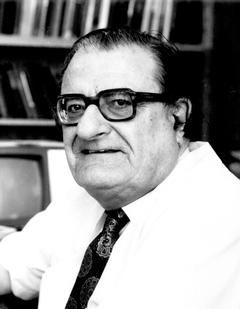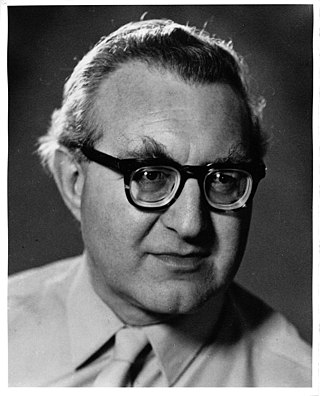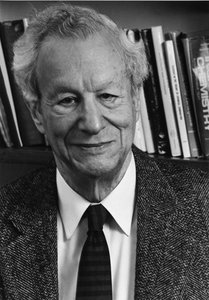Related Research Articles

In organic chemistry, the phenyl group, or phenyl ring, is a cyclic group of atoms with the formula C6H5, and is often represented by the symbol Ph. The phenyl group is closely related to benzene and can be viewed as a benzene ring, minus a hydrogen, which may be replaced by some other element or compound to serve as a functional group. A phenyl group has six carbon atoms bonded together in a hexagonal planar ring, five of which are bonded to individual hydrogen atoms, with the remaining carbon bonded to a substituent. Phenyl groups are commonplace in organic chemistry. Although often depicted with alternating double and single bonds, the phenyl group is chemically aromatic and has equal bond lengths between carbon atoms in the ring.
A substitution reaction is a chemical reaction during which one functional group in a chemical compound is replaced by another functional group. Substitution reactions are of prime importance in organic chemistry. Substitution reactions in organic chemistry are classified either as electrophilic or nucleophilic depending upon the reagent involved, whether a reactive intermediate involved in the reaction is a carbocation, a carbanion or a free radical, and whether the substrate is aliphatic or aromatic. Detailed understanding of a reaction type helps to predict the product outcome in a reaction. It also is helpful for optimizing a reaction with regard to variables such as temperature and choice of solvent.

Raymond Urgel Lemieux, CC, AOE, FRS was a Canadian organic chemist, who pioneered many discoveries in the field of chemistry, his first and most famous being the synthesis of sucrose. His contributions include the discovery of the anomeric effect and the development of general methodologies for the synthesis of saccharides still employed in the area of carbohydrate chemistry. He was a fellow of the Royal Society of Canada and the Royal Society (England), and a recipient of the prestigious Albert Einstein World Award of Science and Wolf Prize in Chemistry.

Professor Basil Charles Leicester Weedon CBE, FRS was an organic chemist and university administrator. Using nuclear magnetic resonance spectroscopy, he was the first to map the structures of carotenoid pigments, including astaxanthin, rubixanthin and canthaxanthin.

Michael James Steuart Dewar was an American theoretical chemist.

Ralph Alexander Raphael was a British organic chemist, well known for his use of acteylene derivatives in the synthesis of natural products with biological activity.

Frank Henry Westheimer was an American chemist. He taught at the University of Chicago from 1936 to 1954, and at Harvard University from 1953 to 1983, becoming the Morris Loeb Professor of Chemistry in 1960, and Professor Emeritus in 1983. The Westheimer medal was established in his honor in 2002.

Charles Wayne Rees CBE FRS FRSC was a British organic chemist.
The Willard Gibbs Award, presented by the Chicago Section of the American Chemical Society, was established in 1910 by William A. Converse (1862–1940), a former Chairman and Secretary of the Chicago Section of the society and named for Professor Josiah Willard Gibbs (1839–1903) of Yale University. Gibbs, whose formulation of the Phase Rule founded a new science, is considered by many to be the only American-born scientist whose discoveries are as fundamental in nature as those of Newton and Galileo.

Duilio Arigoni was a Swiss chemist and Emeritus Professor at ETH Zurich. He worked on the biosynthetic pathways of many organic natural substances.
Christopher Spencer Foote was a professor of chemistry at UCLA and an expert in reactive oxygen species, in particular, singlet oxygen. He published over 250 research articles and has an h-index of 67. He was also known for his textbook Organic Chemistry.
Jeremy Randall Knowles was a professor of chemistry at Harvard University who served as dean of the Harvard University faculty of arts and sciences (FAS) from 1991 to 2002. He joined Harvard in 1974, received many awards for his research, and remained at Harvard until his death, leaving the faculty for a decade to serve as Dean. Knowles died on 3 April 2008 at his home.
Jeremy Keith Morris Sanders is a British chemist and Emeritus Professor in the Department of Chemistry at the University of Cambridge. He is also Editor-in-Chief of Royal Society Open Science. He is known for his contributions to many fields including NMR spectroscopy and supramolecular chemistry. He served as the Pro-Vice-Chancellor for Institutional Affairs at the University of Cambridge, 2011–2015.

Thomas Summers West was a British chemist.
John T. Groves is an American chemist, and Hugh Stott Taylor Chair of Chemistry, at Princeton University.
Guy Charles Lloyd-Jones FRS FRSE is a British chemist. He is the Forbes Professor of Organic Chemistry at the University of Edinburgh in the United Kingdom. His research is largely concerned with the determination of organometallic reaction mechanisms, especially those of palladium-catalyzed coupling reactions such as Suzuki-Miyaura coupling.
Horst Prinzbach was a German chemist and professor emeritus.

Roger Arthur Sheldon is a British chemist who is emeritus professor of Biocatalysis and Organic Chemistry at Delft University of Technology in the Netherlands.
Herman Pines was a Russian Empire–born American chemist best known for his work with Vladimir Ipatieff on the catalytic conversion of high-octane aviation fuel. Because of his scientific contributions, new processes were developed for the isomerization of paraffins, the alkylation of aromatic compounds, and base-catalyzed organic reactions.

Kennedy Joseph Previté-Orton was a British chemist who became a lecturer and demonstrator at St Bartholomew's Hospital and then became a professor at Bangor. He was also a keen climber, amateur geologist, ornithologist and bird conservationist.
References
- 1 2 3 4 5 "BAKER, Prof. Raymond". Who's Who 2013, A & C Black, an imprint of Bloomsbury Publishing plc, 2013; online edn, Oxford University Press.(subscription required)
- ↑ Baker, Raymond (1962). Detritiation Reactions in Aromatic Systems (PhD thesis). University of Leicester.
- ↑ Boche, G. (1973). "Book Review: Mechanism in Organic Chemistry. By R. Alder, R. Baker, and J. M. Brown". Angewandte Chemie International Edition in English. 12 (8): 680–681. doi:10.1002/anie.197306804.